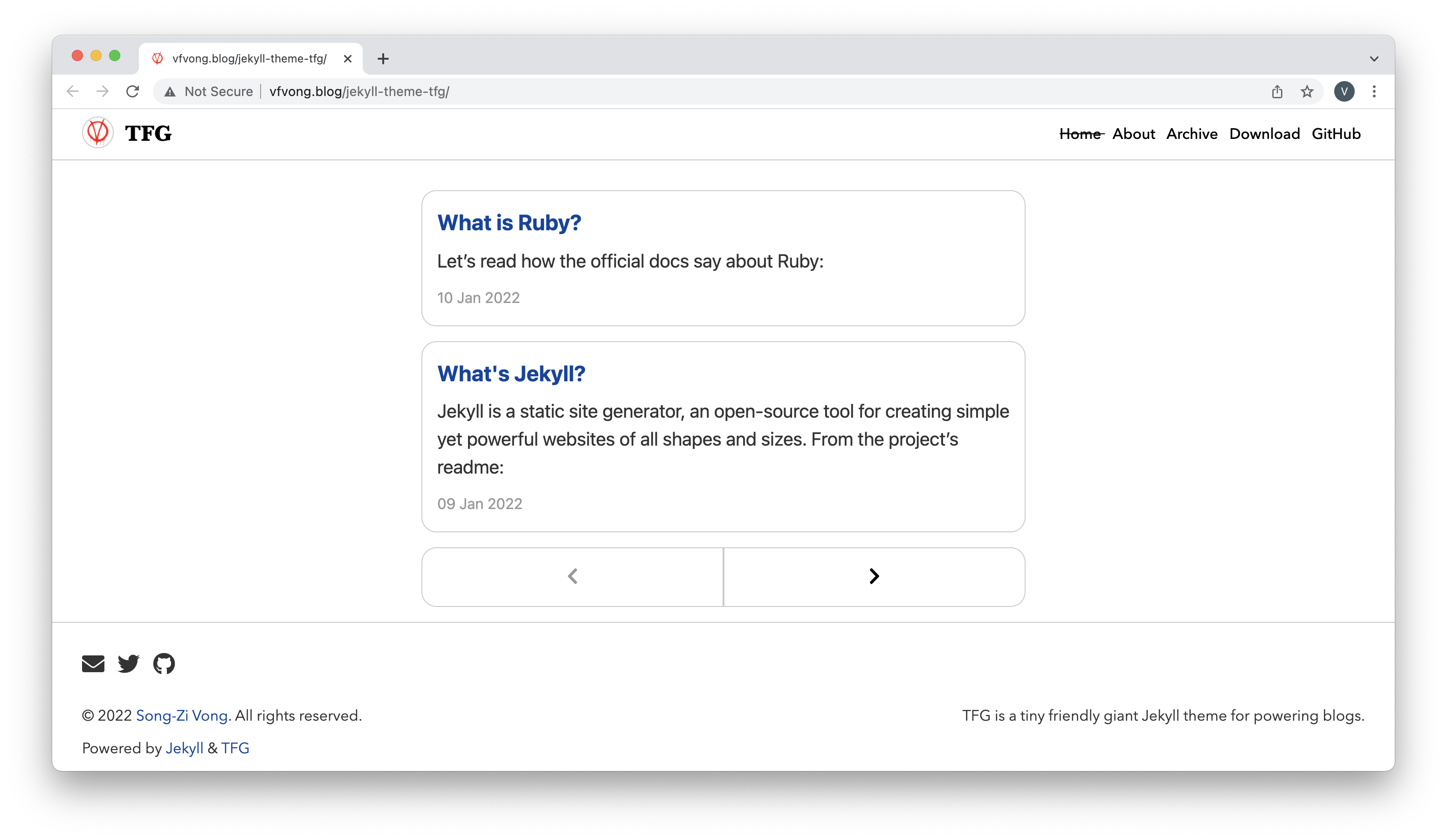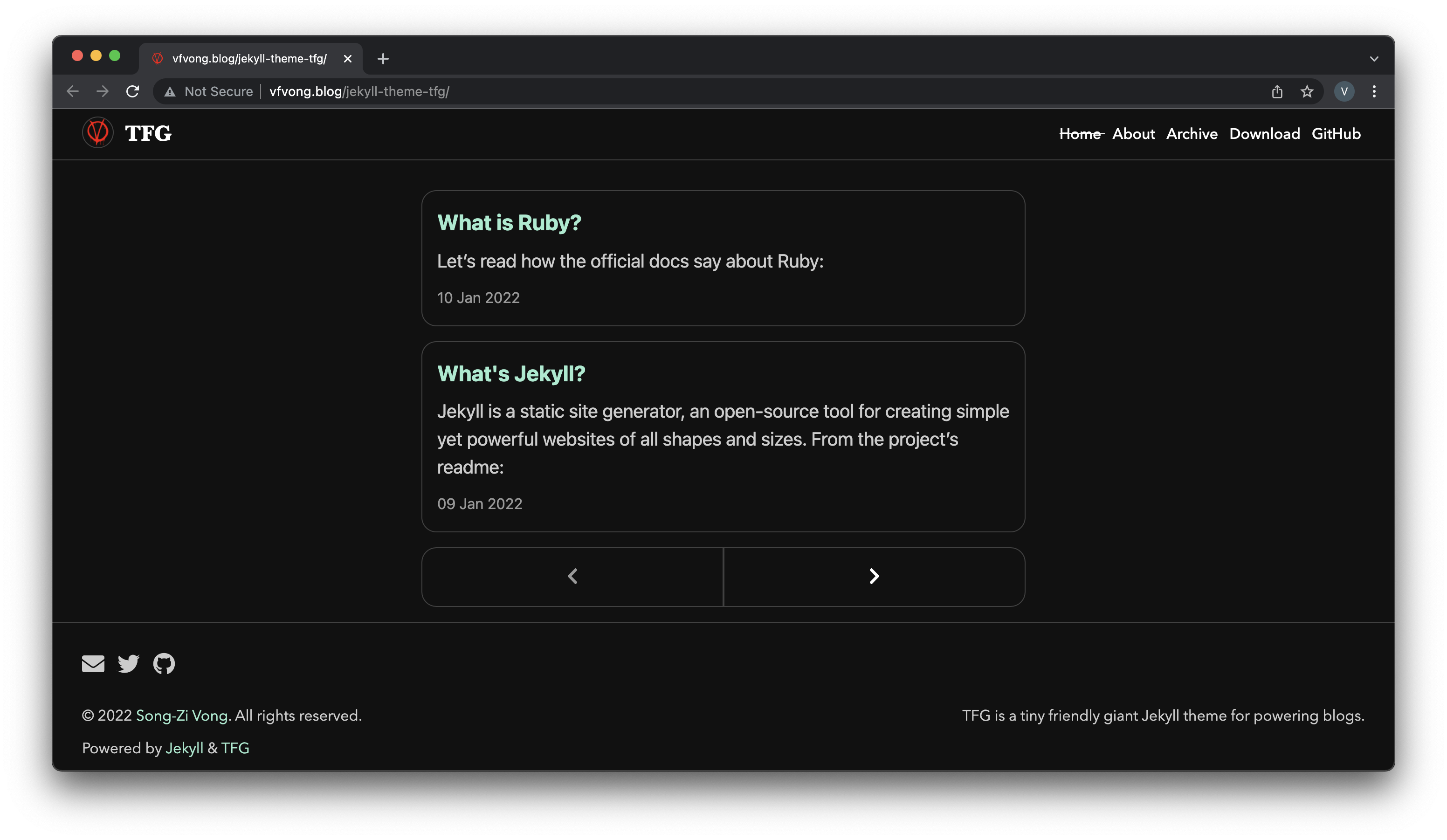Jekyll Theme TFG
TFG is a tiny friendly giant Jekyll theme for powering blogs. The name of this theme is from Koenigsegg Gemera's engine "Tiny Friendly Giant". It is small when it comes to emissions and consumption, and at the same time, it is big when it comes to power, torque, and sound. The target of this theme is similar—While providing friendly and powerful blog functions, try to keep the code and the design as tiny as possible.
TFG is built on Tachyons.
Preview the demo.
Highlight Features
- Light and dark mode, via
prefers-color-scheme - Archive pages implemented in pure Liquid
- Google Analytics 4
- Disqus
- MathJax
- Font Awesome
Table of Contents
Installation
Add this line to your Jekyll site's Gemfile:
gem "jekyll-theme-tfg"And add this line to your Jekyll site's _config.yml:
theme: jekyll-theme-tfgAnd then execute:
$ bundle
Or install it yourself as:
$ gem install jekyll-theme-tfg
If your website is hosted on GitHub Pages, you can install this theme via jekyll-remote-theme.
Add the following to your Gemfile:
gem "jekyll-remote-theme"And add this line to your Jekyll site's _config.yml:
plugins:
- jekyll-remote-themeAdd the following to your site's _config.yml:
remote_theme: vfvong/jekyll-theme-tfgUsage
Ease of use is one of the design goals of TFG. Basically, you only need to refer to the _config.yml file of the demo to set the basic parameters required to run the website.
Customization
You can of course fork the entire repository and make custom changes on your copy, but there is a much cleaner way: after referencing the theme, you just need to copy the _sass/tfg/_variables.scss file to your repository in the corresponding path, and then modify some variables, you can customize the color and fonts you like.
If you want to put some extra data into the <head>, you don't need to overwrite the entire _includes/head.html file, and you just need to create a file _includes/custom-head.html in your repository, and then put your data into there.
Archive Pages
TFG provides a template archive to archive posts by years, categories, or tags.
If you want to show an archive page of years, just create a file and put these front matter in it:
---
layout: archive
type: years
title: Archive by Years
---Similarly, if you want to show an archive page of categories, just create a file and put these front matter in it:
---
layout: archive
type: categories
title: Archive by Categories
---Besides, if you want the categories and tags displayed in the post to link to the archive pages, you need to configure the paths to the category and tag archive pages in the _config.yml file, for example:
categories_path: /categories/
tags_path: /tags/Google Analytics 4
TFG support the Google Analytics 4. To enable it, just set the Measurement ID in the _config.yml, for example,
google_analytics: G-XXXXXXXXXXDisqus
To enable Disqus, just set the Disqus shortname in the _config.yml, for example,
disqus: <your disqus shortname>MathJax
TFG relies on the MathJax to render math. The MathJax is disabled by default. You need to set math: true on the page where you want to enable the MathJax.
Navigation
The navigation in TFG is very easy to configure, just specify the titles and URLs in the _data/navigation.yml file, for example,
- title: Home
url: /
- title: About
url: /about.html
- title: Archive
url: /archive.htmlSocial Links
The social links in TFG is also very easy to connfigure. You don't need to import any large SVG file to render the icons because TFG supports the Font Awesome. Specify the titles, URLs, and icons in the _data/social.yml file, for example,
- title: Email
url: mailto:vfvong@gmail.com
icon: fas fa-envelope
- title: Twitter
url: https://twitter.com/vfvong
icon: fab fa-twitter
- title: GitHub
url: https://github.com/vfvong
icon: fab fa-githubContributing
Bug reports and pull requests are welcome on GitHub at https://github.com/vfvong/jekyll-theme-tfg. This project is intended to be a safe, welcoming space for collaboration, and contributors are expected to adhere to the Contributor Covenant code of conduct.
Development
To set up your environment to develop this theme, run bundle install.
Your theme is setup just like a normal Jekyll site! To test your theme, run bundle exec jekyll serve and open your browser at http://localhost:4000. This starts a Jekyll server using your theme. Add pages, documents, data, etc. like normal to test your theme's contents. As you make modifications to your theme and to your content, your site will regenerate and you should see the changes in the browser after a refresh, just like normal.
When your theme is released, only the files in _layouts, _includes, _sass and assets tracked with Git will be bundled.
To add a custom directory to your theme-gem, please edit the regexp in jekyll-theme-tfg.gemspec accordingly.
License
The theme is available as open source under the terms of the MIT License.

